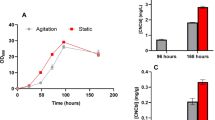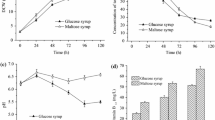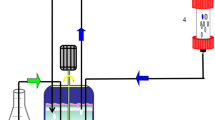Abstract
In order to improve the productivity of vitamin B12 by Pseudomonas denitrificans carried out in a 120-m3 fermenter, the effect of pH on vitamin B12 biosynthesis was investigated. Results obtained from shake flask experiments showed that the feeding of carbon source (beet molasses or glucose) and methyl-group donor (betaine or choline chloride) significantly influenced the pH and the biosynthesis of vitamin B12. In contrast to beet molasses or choline chloride, using glucose as a feed medium and betaine as a methyl-group donor, pH could be maintained at a stable range. As a result, higher vitamin B12 production was achieved. Accordingly, an effective and simplified pH-stat control strategy was established for the fermentation of vitamin B12 in a 120-m3 industrial fermenter. When the new pH control strategy was applied, pH was stably kept in the range of 7.15–7.30 during fermentation. Thus, 214.3 μg/mL of vitamin B12 was achieved.




Similar content being viewed by others
References
Hunik JH (2002) Process for the production of vitamin B12. US Patent 6,492,141B1 Dec 2002
Battersby AR (1994) Science 264:1551–l557
Blanche F, Cameron B, Crouzet J, Battersby AR (1995) Angew Chem Int Ed Engl 34:383–411
Warren MJ, Evelyne R, Schubert HL, Escalante-Semerena JC (2002) Nat Prod Rep 19:390–412
Battersby AR, Leeper FJ (1998) Top Curr Chem 195:143–193
Eschenmoser A (1974) Naturwissenschaften 61:513–525
Martins JH, Barg H, Warren MJ, Jahn D (2002) Appl Microbiol Biotechnol 58:275–285
Moat AG, Foster JW (1988) Microbial Physiology, 2nd edn. Wiley, NY, pp 21–24
Elmahdi I, Baganz F, Dixon K, Harrop T, Sugden D, Lye GJ (2003) Biochem Eng 16:299–310
Amanullah A, McFarlane CM, Emery AN, Nienow AW (2001) Biotechnol Bioeng 73:390–399
Zheng MY, Du GC, Chen J (2002) Enzyme Microb Technol 31:477–481
Zhu J (1981) Biochemistry Experiment. Shanghai Scientific and Technical Publishers, Shanghai
Sanchez S, Demain AL (2002) Enzyme Microb Technol 31:895–906
Zhu Y, Rinzema A, de Bruin E, Bol J (1998) Appl Microbiol Biotechnol 49:251–257
Shang F, Wen SH, Wang X, Tan TW (2006) J Biotechnol 122:285–292
Shukla VB, Zhou S, Yomano LP, Shanmugam KT, Preston JF, Ingram LO (2004) Biotechnol Lett 26:689–693
Wee Y, Kim J, Yun J, Ryu H (2004) Enzyme Microb Technol 35:568–573
Jiménez AM, Borja R, Martin A (2004) Biochem Eng J 18:121–132
Rodrigues LR, Teixeira JA, Oliveira R (2006) Biochem Eng J 32:135–142
Csonka LN (1989) Microbiol Rev 53:121–147
Kempf B, Bremer E (1998) Arch Microbiol 170:319–330
Felitsky DJ, Cannon JG, Capp MW, Hong J, Wynsberghe AWV, Anderson CF, Record MT (2004) Biochemistry 43:14732–14743
Demain AL, Daniels HJ, Schnable L, White RF (1968) Nature 220:1324–1325
Fa YH, Kusel JP, Demain AL (1984) Appl Environ Microbiol 47:1067–1069
Roman RV, Iluc E, Mustea A, Neacsu A, Asandului V (2001) Roum Biotechnol Lett 6:343–350
Roeb GA, Sun CS, Gerard C, Ian B, Billy D, Nigel TH, Frank B (2005) Biochem Eng J 23:221–230
Lee SY (1996) Trends Biotechnol 14:98–105
Acknowledgments
This work was supported by National Basic Research Program (973 Program, No. 2007CB714303) and Shanghai Leading Academic Discipline Project (B505). We are grateful to Shijiazhuang Pharma. Group Hua Rong Pharmaceutical Co. Ltd for their support in this work.
Author information
Authors and Affiliations
Corresponding author
Rights and permissions
About this article
Cite this article
Li, KT., Liu, DH., Chu, J. et al. An effective and simplified pH-stat control strategy for the industrial fermentation of vitamin B12 by Pseudomonas denitrificans . Bioprocess Biosyst Eng 31, 605–610 (2008). https://doi.org/10.1007/s00449-008-0209-5
Received:
Accepted:
Published:
Issue Date:
DOI: https://doi.org/10.1007/s00449-008-0209-5




